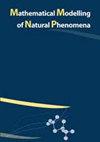肿瘤干细胞拥挤和生长之间的相互作用:概念数学模型
IF 2.1
4区 数学
Q2 MATHEMATICAL & COMPUTATIONAL BIOLOGY
引用次数: 0
摘要
本文提出了一种在存在永生多能癌症干细胞(CSCs)和几种分化肿瘤细胞(CC)谱系的情况下肿瘤生长的概念模型。假设CSCs的复制是对称或不对称的,具有规定的平均比例,并将有丝分裂和凋亡考虑到CC的老化。细胞的局部拥挤可能会阻碍复制。该模型是在三维细胞自动机(CA)的框架下实现的,其动力学由随机规则控制。模拟显示了肿瘤的生长以及不同谱系和年龄级别的CC的部分。然后,提出了一种方法,该方法考虑了衰老、复制和凋亡的相同动力学,但研究了不同谱系和时间级别的细胞部分在总体积上的平均时间演变。动力学由常微分方程组(ODEs)控制,因此由确定性规则控制。该系统解的数值模拟显示与CA结果在质量上相似,尽管拥挤效应不再是局部效应,而是在总体积上取平均值。证明了该模型的数学适定性。本文章由计算机程序翻译,如有差异,请以英文原文为准。
Interaction between crowding and growth in tumours with stem cells: conceptual mathematical modelling
The paper proposes a conceptual modelling of growth of tumours in presence of immortal multipotent cancer stem cells (CSCs) and several lineages of differentiated tumour cells (CCs).
The replication of CSCs is assumed symmetric or asymmetric with a prescribed mean ratio and mitosis and apoptosis are taken into account for the CCs aging. Replication can be hindered by the local crowding of the cells.
The model is implemented in the framework of 3D cellular automata (CA) whose dynamics is governed by stochastic rules. Simulations are displayed showing the growth of a tumour and the fractions of different lineages and age classes of CCs.
Then, an approach that considers the same dynamics of aging, replication, and apoptosis, but studying the time evolution of the fractions of the different lineages and age classes of cells averaged over the total volume is presented. The dynamics is governed by a system of ordinary differential equations (ODEs), hence by deterministic rules. Numerical simulations of the solution of this system show qualitative similarity with the CA results, although the crowding effect is no longer a local effect, but averaged over the total volume. The proof of the mathematical well-posedness of this model is provided.
求助全文
通过发布文献求助,成功后即可免费获取论文全文。
去求助
来源期刊

Mathematical Modelling of Natural Phenomena
MATHEMATICAL & COMPUTATIONAL BIOLOGY-MATHEMATICS, INTERDISCIPLINARY APPLICATIONS
CiteScore
5.20
自引率
0.00%
发文量
46
审稿时长
6-12 weeks
期刊介绍:
The Mathematical Modelling of Natural Phenomena (MMNP) is an international research journal, which publishes top-level original and review papers, short communications and proceedings on mathematical modelling in biology, medicine, chemistry, physics, and other areas. The scope of the journal is devoted to mathematical modelling with sufficiently advanced model, and the works studying mainly the existence and stability of stationary points of ODE systems are not considered. The scope of the journal also includes applied mathematics and mathematical analysis in the context of its applications to the real world problems. The journal is essentially functioning on the basis of topical issues representing active areas of research. Each topical issue has its own editorial board. The authors are invited to submit papers to the announced issues or to suggest new issues.
Journal publishes research articles and reviews within the whole field of mathematical modelling, and it will continue to provide information on the latest trends and developments in this ever-expanding subject.
 求助内容:
求助内容: 应助结果提醒方式:
应助结果提醒方式:


